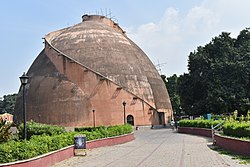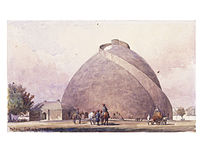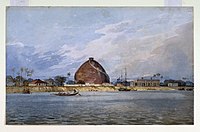| Golghar | |
|---|---|
 Golghar Golghar | |
| Former names | The Granary at Patna |
| General information | |
| Architectural style | Stupa |
| Location | Patna, Bihar, India |
| Coordinates | 25°37′13″N 85°08′22″E / 25.6203374°N 85.1394483°E / 25.6203374; 85.1394483 |
| Completed | 20 July 1786 |
| Owner | Bihar Government |
| Height | 29 m |
| Dimensions | |
| Diameter | 32m-35m (Not sure). |
| Design and construction | |
| Architect(s) | Captain John Garstin |
The Golghar or Gol Ghar (गोलघर), ("Round House") is a large granary located to the west of the Gandhi Maidan in Patna, capital of Bihar state, India.
History
According to a contemporary inscription at its base, the Golghar in Patna was intended to be just the first of a series of huge grain stores. In the end, however, no others were ever built. The granary was "part of a general plan … for the perpetual prevention of famine in these provinces".
The beehive - shaped structure was designed by John Garstin of the Bengal Engineers, part of the East India Company's Bengal Army. Its construction was completed on 20 July 1786.
A drive to improve the appearance of the structure was begun in 2002.
Architecture
Built in the Stupa architecture, the building has a height of 29 m. It is pillar-less with a wall of thickness of 3.6 m at the base. One can climb to the top of the Golghar via its 145-step spiral stairway. The spiral staircase was designed to facilitate the passage of the workers who loaded and unloaded the grain in the granary, who had to carry grain-bags up one flight, deliver their load through a hole at the top, and descend the other stairs.
The top of the Golghar presents a panoramic view of the city and the Ganges.
Golghar has never been filled to its maximum capacity and there are no plans to do so. Some have claimed that the reason for this is a flaw whereby the doors are designed to open inwards; thus, if it is filled to its maximum capacity, then the doors will not open. However, visitors have found that the doors open outwards. Presently renovation of this historical monument is underway.
In popular culture
Golghar was shown in 2019 Hindi film India's Most Wanted.
Gallery
-
 Golghar, Patna, painting of 1888
Golghar, Patna, painting of 1888
-
 Gol Ghar, Patna, a 19th-century painting
Gol Ghar, Patna, a 19th-century painting
-
 Gol Ghar, Patna 19th century painting, by Sita Ram
Gol Ghar, Patna 19th century painting, by Sita Ram
-
 Golghar in July 2022
Golghar in July 2022
See also
- Sabhyata Dwar
- Samrat Ashok International Convention Centre
- Buddha Smriti Park
- Bihar Museum
- List of tallest domes
References
- ^ Morris, Jan; Winchester, Simon (1 January 2005). Stones of Empire: The Buildings of the Raj. Oxford University Press. ISBN 9780192805966.
- Development of Golghar as tourist site in limbo The Times of India, 15 February 2002.
- Das, Arvind N. (1992). The Republic of Bihar. Penguin Books. p. 27. ISBN 978-0-14-012351-7.
- "Golghar renovation work to resume as govt gives additional funds". The Times of India. 4 May 2018. Retrieved 5 May 2022.
- "Patna an ideal place for film shoot, says Arjun". The Times of India.